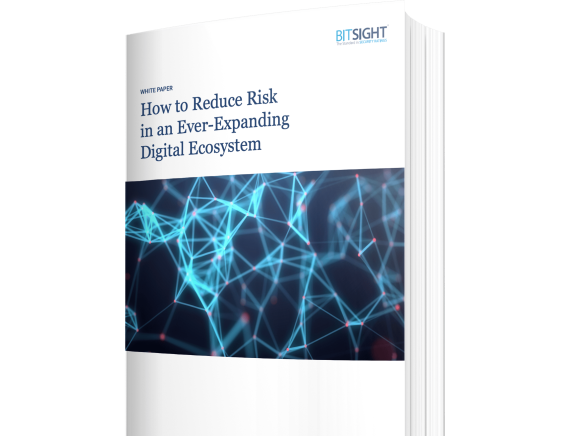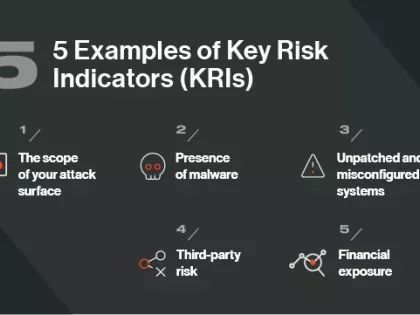With companies racing to achieve digital transformation via the cloud, the Internet of Things (IoT), and bring your own device (BYOD) policies, digital ecosystems are expanding faster than ever. Learn how to protect against threat actors that are taking advantage of new vulnerabilities that are harder to detect.
Mitigating Risk in Your Expanding Digital Ecosystem

As time goes on, organizations are taking on more and more new digital transformation initiatives to become increasingly agile and boost productivity — dramatically transforming the number of digital touchpoints employees interact with on a day-to-day basis.
According to an AccessData/CCBJ survey, almost 70 percent of organizations allow employee use of personal devices for work-related purposes. In addition, organizations are expanding their vendor networks: 60% worked with more than 1,000 third parties in 2019, according to Gartner. Finally, more and more organizations are storing their valuable data on the cloud. In fact, up to 60% of organizations will use an external service provider’s cloud managed service offering by 2022, which is double the percentage of organizations from 2018.
Unfortunately, as your digital ecosystem expands, so does your attack surface. This makes you increasingly vulnerable to cyber risk, as cyber attackers are looking to exploit unmonitored and unknown websites and infrastructures. In particular, migration to the cloud can make maintaining your desired security posture increasingly complex. You have to understand the shared responsibility model for every cloud vendor you work with — and make sure each cloud instance is configured securely. If you don’t, you can open yourself up to major cyber risk. For instance, the Cloud Hopper attacks originated from a penetration of just a few major cloud providers. The ramifications were widespread however, as the attack on cloud services allowed the hackers access to almost all of their customers, creating one of the largest cybersecurity breaches in history.
Within this threat landscape, it’s more important than ever that you have broad and continuous visibility into all your assets across your digital ecosystem.
Stay ahead of the threats
In order to protect your critical assets, you must establish a strong, effective security performance management program. Ultimately, your goal is to be able to measure the performance of your cybersecurity efforts, allocate resources to the most critical areas of cyber risk, and facilitate data-driven conversations around cybersecurity among key stakeholders.
Growing and maintaining your cybersecurity program requires your IT and Security teams to be able to do the following:
1. Understand your digital footprint
As outlined above, your team needs to have continued visibility into your entire digital ecosystem. This means that you must be able to validate and manage your digital footprint across a complex environment. If your organization is global or contains subsidiaries, this includes insight and context into where risk may be present in various geographies and business units. Overall, it’s essential that you can track and monitor all the digital assets associated with your organization.
2. Assess your cyber risk exposure
In order to have a full grasp on your organization’s exposure to risk, you need to have a strategy in place to discover Shadow IT and other unknown threats hiding throughout your extended ecosystem. If your security manager has an incomplete view of infections, failures, and weaknesses in your existing controls, your organization can be increasingly vulnerable to attack.
3. Monitor your cloud environment
If your organization leverages a cloud infrastructure, it should be your goal to continuously monitor your security posture in your cloud environment — in the same way you monitor the rest of your overall security program. As your digital ecosystem expands, it’s critical that you understand which assets are in the cloud, and whether or not those cloud instances are configured correctly to properly secure the assets.
4. Prioritize your remediation efforts
In order to get the greatest ROI for your cybersecurity initiatives, you must allocate your limited resources based on the criticality and level of risk associated with each asset. For instance, you should prioritize remediating any incidents that involve a critical asset with a high risk of breach. Of course, if you have a large digital ecosystem and don’t have the right tools to give you visibility into it, you’ll have to filter through massive amounts of data in order to identify the most severe or potentially severe security events. If you don’t have enough information to give context to your current cybersecurity outlook, it can be difficult to make prioritization decisions and hold appropriate teams accountable for their progress over time.

5. Continuously monitor your program effectiveness
One of your primary goals should be to continuously optimize your cybersecurity program. This requires your organization to have a process in place to evaluate your security performance, set up goals to continually improve, track progress, and report outcomes to key business stakeholders. Here, it’s critical that you have a common, standard set of cyber security KPIs to use to measure and communicate the effectiveness of your security program over time. According to Forrester, “companies that have implemented formal security performance metrics are more likely to have seen a 10% or greater increase in security budget year over year.” As security ratings are a data-driven, objective, and dynamic measure of security performance, thousands of organizations around the world use this KPI to manage cyber risk where transparency may have historically been lacking.
Get more visibility and context into your digital ecosystem
Of course, one of the biggest challenges your organization may be facing when it comes to mitigating cyber risk is having a way to get continuous, broad visibility into your attack surface — particularly in the cloud. As your digital ecosystem continues to expand, you may find that you have difficulty keeping track of your critical assets and filtering through massive amounts of data to identify the most severe or potentially severe security events. This makes it challenging for you to prioritize your remediation efforts — ultimately leaving you with an incomplete view of your organization's overall cyber risk and the fear of becoming victim of a potentially costly data breach.
Given these current industry challenges, Bitsight is extremely excited to announce the launch of Attack Surface Analytics With Cloud Visibility. This new release provides Risk Intelligence insights that give more context into your Bitsight Security Rating than ever before. With our new hosting provider data and cloud visibility, you can understand the risk profile of all your assets — whether they’re hosted on-premise or in the cloud.
Furthermore, you can leverage additional context to make informed, comparative decisions about what cybersecurity efforts to prioritize and focus on. Our new dashboard outlines where all your assets are located — broken down by geography and business unit — and the corresponding risk. If you’re a manager looking to lead and streamline remediation efforts for any assets you own, you can use the new table to easily sort through your cybersecurity findings by asset.
Boost your cybersecurity ROI
In order to get the most out of the money and effort you invest in your cybersecurity program, you must strive to improve your performance over time. By measuring the change in your security posture through a standard set of cyber risk KPIs — like security ratings — you can track that improvement and determine whether you’re using your resources effectively.
And, in today’s threat climate, a major factor in your ability to improve your performance is whether your organization has broad and continuous visibility into its digital footprint. After all, you can’t secure what you can’t see. This context empowers your IT and Security teams to detect unknown risk hiding throughout your digital ecosystem, identify weak areas of your security program, and find failed security controls that require improvement. And these are the types of insights you need to use your tools and resources most effectively. Once you have the necessary visibility into your ever-evolving digital ecosystem, you can always feel confident that you are allocating your limited resources on those program areas that will lead to the biggest return on investment — making it easier than ever for you to align security to the business.


